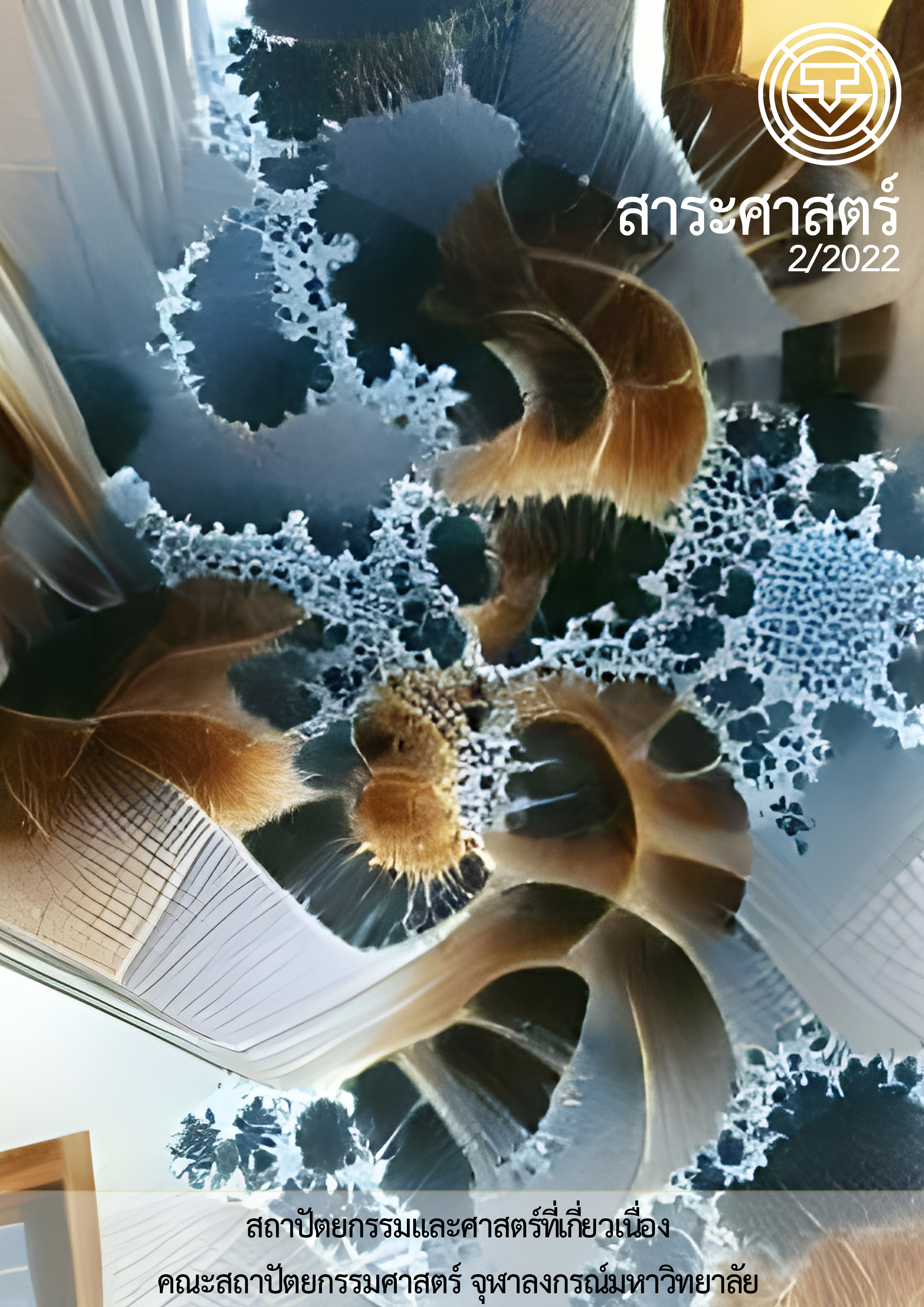Roles of Vegetation on Air Quality Management and PM2.5 Mitigation Bang Chalong National Housing Authority Project Amphoe Bang Phli, Samutprakarn
Main Article Content
Abstract
PM2.5 has been the cause of critical urban environmental problems during the past decade. Although there is a wide range of research on air pollution mitigation strategies using trees and urban forests, there are other factors that can mitigate high PM2.5. The air pollution problem is unperceivable and even though the health impact from PM2.5 is severe, it is not sudden which makes it difficult to bring it to public awareness. Especially in low-income neighborhoods or public housing projects where environmental injustices are perpetual, how can we create a green areas design guideline for green communities where green spaces do not merely provide an aesthetic function but also serve ecological functions and improve health and wellbeing? The purpose of the study is to examine the relationship between green spaces and air pollution. The research consists of two parts. First, the study compares the air quality data, focusing on PM2.5, with green area ratio and leaf volumes in selected locations. By installing 20 air quality monitoring sensors at different locations in Bang Chalong National Housing Authority Project, PM 2.5 data were collected during the months of highest PM 2.5 levels. The second part is to examine the residents’ perception of air pollution, their understanding on the effect of vegetation on air quality management and PM2.5 mitigations and the relationships between green spaces, vegetation, and air pollution.
Article Details
References
กรมควบคุมมลพิษ. (2564). ข้อมูลดัชนีคุณภาพอากาศ. สืบค้นเมื่อ 6 มกราคม 2564, จาก http://air4thai.pcd.go.th/webV2/aqi_info.php
กระทรวงทรัพยากรธรรมชาติและสิ่งแวดล้อม. (2563). คพ.ประสานเตรียมรับมือ PM2.5 จากการเดินทางกลับ กทม. หลังเทศกาลปีใหม่. สืบค้นจาก กรมควบคุมมลพิษ กระทรวงทรัพยากรธรรมชาติและสิ่งแวดล้อม (blog) http://pcd.go.th/Public/News/GetNewsThai.cfm?task=lt2020&id=19244
การเคหะแห่งชาติ. (2556). ผลการปฏิบัติตามมาตรการป้องกันและแก้ไขผลกระทบสิ่งแวดล้อมและมาตรการติดตามตรวจสอบคุณภาพสิ่งแวดล้อม ระยะดำเนินการระหว่างเดือนมกราคม - มิถุนายน พ.ศ. 2556 โครงการบ้านเอื้ออาทร บางโฉลง ระยะที่ 3/1 และ 3/2 สมุทรปราการ ซอยวัดบางโฉลงนอก ตำบลบางโฉลง อำเภอบางพลี จังหวัดสมุทรปราการ การเคหะแห่งชาติ. กรุงเทพมหานคร: การเคหะแห่งชาติ-บริษัท เอเชีย แล็ป แอนด์ คอนซัลแตนท์ จำกัด. สืบค้นจาก http://eiadoc.onep.go.th/eia2/5-7-323.pdf
Leechaisit, Ronnakorn. (2004). ฝุ่นละออง Particulate Matter. สืบค้นจาก กรมควบคุมมลพิษ กระทรวงทรัพยากรธรรมชาติและสิ่งแวดล้อม. ทำความรู้จักPM2.5 (blog) http://www2.pcd.go.th/info_serv/air_pm25.html
วิษณุ บาคาล. (2564). มาตรการทางกฎหมายที่ใช้ต่อการควบคุมและป้องกันมลพิษฝุ่น PM 2.5. วารสารสังคมศาสตร์เพื่อการพัฒนาท้องถิ่น มหาวิทยาลัยราชภัฏมหาสารคาม, 5(1), 297–306.
Escobedo, F. J., & Nowak, D. J. (2009). Spatial heterogeneity and air pollution removal by an urban forest. Landscape and Urban Planning, 90(3–4), 102–110. Retrieved from https://doi.org/10.1016/j.landurbplan.2008.10.021
Health Effects Institute. (2019). State of global air 2019: A special report on global exposure to air pollution and its disease burden; Special report. Boston: Health Effects Institute and the Institute for Health Metrics and Evaluation’s Global Burden of Disease Project.
Institute for Health Metrics and Evaluation [IHME]. (2018). Findings from the global burden of disease study 2017. Retrieved from https://www.indexmundi.com/facts/indicators/EN.ATM.PM25.MC.ZS#:~:text=The%20guideline%20set%20by%20the%20World%20Health%20Organization,emissions%20of%20PM2.5%20from%20burning%20fuels%20in%20households.
Nguyen, Thithanhthao, Xinxiao Yu, Zhenming Zhang, Mengmeng Liu, & Xuhui Liu. (2015). Relationship between types of urban forest and PM2.5 capture at three growth stages of leaves. Journal of Environmental Sciences, 27, 33–41.
Nowak, David J. (1994). Atmospheric carbon dioxide reduction by Chicago’s urban forest. In Chicago’s urban forest ecosystem: Results of the Chicago urban forest climate project (pp. 82–94). Radnor, PA: U.S. Department of Agriculture, Forest Service, Northeastern Forest Experiment Station.
Nowak, D. J., Hirabayashi, S., Doyle, M., McGovern, M., & Pasher, J. (2018). Air pollution removal by urban forests in Canada and its effect on air quality and human health. Urban Forestry & Urban Greening, 29, 40–48. Retrieved from https://doi.org/10.1016/j.ufug.2017.10.019
Sieghardt, Monika, Erich Mursch-Radlgruber, Elena Paoletti, Els Couenberg, Alexandros Dimitrakopoulus, Francisco Rego, …Thomas Barfoed Randrup. (2005). The abiotic urban environment: Impact of urban growing conditions on urban vegetation. In Urban forests and trees: A reference book (pp. 281–323). Heidelberg: Springer Science-Business Media.
Tyrväinen, Liisa, Stephan Pauleit, Klaus Seeland, & Sjerp de Vries. (2005). Benefits and uses of urban forests and trees. In Urban forests and trees: A reference book (p. 520). Heidelberg: Springer Science-Business Media.
Yang, Jun, Joe R. McBride, Jinxing Zhou, & Zhenyuan Sun. (2005). The urban forest in Beijing and its role in air pollution reduction. Urban Forestry & Urban Greening, 3(2), 65–78. Retrieved from https://doi.org/10.1016/j.ufug.2004.09.001

